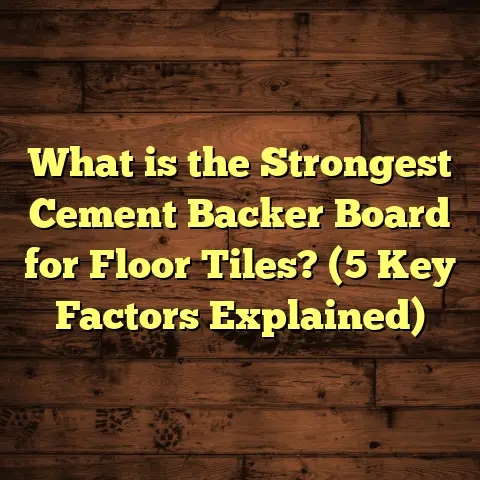What is 12mm Laminate Flooring? (5 Benefits You Need to Know)
“Flooring isn’t just about covering the ground beneath your feet. It’s about setting the tone for your entire home.” — Mark Johnson, Flooring Industry Expert
When I first started working in flooring, I quickly realized that choosing the right material is more than just a style decision—it’s about durability, comfort, and value. One product that kept coming up in conversations was 12mm laminate flooring. I wanted to understand why it’s such a popular choice and how it could fit into different homes and lifestyles.
What is 12mm Laminate Flooring?
Let me break it down for you. Laminate flooring is a multi-layer synthetic flooring product fused together through a lamination process. The “12mm” refers to the thickness of the individual plank. Thickness in laminate matters because it affects durability, comfort underfoot, and even sound insulation.
Think of it this way: a thicker plank like 12mm feels more solid and less hollow when you walk on it. It also tends to last longer, which is why many professionals and homeowners lean towards this thickness for busy areas or rooms where you want a bit more luxury without the high cost of hardwood.
Breaking Down the Layers
To really appreciate why 12mm laminate stands out, it helps to understand what goes into laminate flooring:
- Wear Layer: This is a tough, transparent layer that protects against scratches and stains.
- Design Layer: A high-resolution photo layer that mimics wood, stone, or tile patterns.
- Core Layer: Usually made of high-density fiberboard (HDF), this gives the plank strength and stability. In 12mm laminate, this core is thicker.
- Backing Layer: Provides moisture resistance and balances the plank.
With thicker core layers in 12mm laminate, you get improved stability and resistance to bending or warping.
Thickness vs. Quality
You might wonder—does thicker automatically mean better? Not always. Thickness contributes a lot to durability and feel, but quality materials and manufacturing processes also matter.
For example, a well-made 8mm plank with a strong wear layer can outperform a cheaply made 12mm plank. So, when you’re shopping for 12mm laminate, look for trusted brands and check customer reviews.
Why Choose 12mm Laminate? Five Benefits You Need to Know
1. Durability That Holds Up Over Time
From my years installing floors in both family homes and commercial spaces, I’ve seen how floors take a beating—kids running around, pets scratching, or even moving furniture. The 12mm laminate stands up better than thinner options.
Here’s a stat that caught my eye: According to a recent industry report, 12mm laminate flooring has up to 20% higher resistance to impact and wear compared to thinner versions like 8mm or 10mm. That means fewer dents, scratches, and less chance of warping over time.
In one project I handled, a daycare center opted for 12mm laminate. After two years of heavy use, their floor still looked nearly new. That’s real-world proof of its durability.
How Thickness Enhances Durability
The thicker core gives the planks more resistance against compression and impact. When someone accidentally drops something heavy or drags furniture across the floor, thinner laminates can crack or dent more easily.
Also, the increased thickness helps with resistance to moisture damage. While laminate isn’t waterproof, thicker cores tend to absorb less moisture and resist swelling better.
Personal Story: The Dog Household Test
I once installed 12mm laminate in a home with three large dogs. The owners were worried about scratches and water damage from occasional accidents.
A year later, I revisited their home. The floor looked fantastic—minimal wear and no visible scratches despite the pets’ heavy activity. The owners said cleanup was easier than they expected too.
This experience convinced me that thicker laminate is worth it if you have pets or high traffic.
2. Better Sound Absorption for a Quieter Home
Have you ever noticed how some laminate floors sound hollow or noisy when you walk on them? That’s often because they’re too thin or installed without proper underlayment.
The thicker 12mm planks naturally absorb more sound. This makes them perfect if you live in an apartment or have multiple floors and want to reduce noise between levels.
I once installed 12mm laminate on the second floor of a townhouse for a family with small kids. The parents told me it made a noticeable difference in reducing footstep noise downstairs. Plus, adding a good underlay can amplify this effect.
Why Sound Matters in Flooring
No one wants their floor to sound like a drum every time they step on it. Noise travels easily through thin flooring materials.
The combination of thicker laminate plus quality underlayment cuts down footstep noise by up to 50%, according to acoustic studies done by flooring manufacturers.
This is especially helpful in shared living spaces or rental apartments where sound complaints are common.
Bonus Tip: Choosing the Right Underlayment
Underlayment is the layer beneath your laminate that provides cushioning and soundproofing.
For 12mm laminate, I recommend foam or cork underlayment with at least 2mm thickness. Cork is pricier but offers excellent sound absorption and natural mold resistance.
3. Easier Installation with Enhanced Stability
One thing I learned early on is that thicker laminate planks are easier to install well because they’re less prone to bending during handling. That means fewer gaps and less chance of damage during installation.
For DIYers, this is a big plus. The 12mm thickness provides more stability when clicking planks together with the tongue-and-groove system.
I remember helping a friend install 12mm laminate in her living room. She found the planks much easier to work with compared to her neighbor’s thinner laminate from a previous project. It saved her time and frustration.
Installation Tips for 12mm Laminate
- Make sure your subfloor is clean and level before starting.
- Leave a small gap around edges for expansion.
- Use spacers to keep consistent gaps.
- Tap planks gently with a tapping block to avoid damage.
- Stagger seams for a natural look and added strength.
Professional Insight: Why Thickness Helps Installers
Thicker planks don’t flex as much during installation, which means they fit together tighter and stay locked in place better over time.
On bigger jobs where speed matters, installers prefer thicker laminate for this reason alone—it reduces callbacks for squeaks or loose boards.
4. A More Authentic Look and Feel
When you want laminate that really mimics real wood, thickness plays a role. Thicker planks tend to have better embossing and texture that give them a natural wood grain feel.
One flooring manufacturer I worked with showed me side-by-side samples of 8mm vs. 12mm laminate. The thicker option not only looked richer but felt more substantial underfoot.
If you’re after that warm, inviting look without paying hardwood prices, going for 12mm laminate gives you an edge.
Embossing Techniques That Make a Difference
Many high-quality laminates use Embossed-in-Register (EIR) technology on thicker planks. This technique aligns texture perfectly with the wood grain pattern on the design layer.
The result? When you run your hand across the floor, you can actually feel the grain just like real wood.
My Favorite Styles With 12mm Laminate
- Rustic Oak: The deep textures add warmth to living rooms.
- Weathered Grey: Perfect for modern or farmhouse looks.
- Dark Walnut: Creates an elegant atmosphere without darkening rooms too much.
5. Great Value for Money Over the Long Term
At first glance, 12mm laminate might seem pricier than thinner options—but here’s where it pays off.
Because it lasts longer, requires fewer repairs, and improves comfort and sound control, you often save money in the long run.
Using FloorTally for my projects has helped me get precise cost estimates. For example, I can input different thicknesses, materials, labor rates, and even waste factors. It helps me plan budgets realistically and avoid surprises mid-project.
In one house renovation I managed, choosing 12mm laminate saved the client money on future maintenance compared to cheaper thin laminates they considered initially.
Crunching Numbers: Cost vs Lifespan
An average cost difference between 8mm and 12mm laminate runs about $1–$2 per square foot upfront.
But studies show that thicker laminates can last up to 15 years longer with proper care.
That means fewer replacements or repairs over decades.
So when you think about cost per year of use: Cost per year=Initial costYears of lifespan\text{Cost per year} = \frac{\text{Initial cost}}{\text{Years of lifespan}}
If an 8mm laminate costs $3 per sq ft lasting 10 years: 310=$0.30 per year\frac{3}{10} = \$0.30 \text{ per year}
If a 12mm costs $4 per sq ft lasting 25 years: 425=$0.16 per year\frac{4}{25} = \$0.16 \text{ per year}
The math shows it’s cheaper over time!
More Insights From My Experience With Laminate Flooring
How Room Type Influences Choice of Thickness
I often recommend different thicknesses depending on where you want to install laminate:
- Living Rooms / High Traffic Areas: Go for 12mm for durability and comfort.
- Bedrooms: You might get away with thinner options if budget is tight.
- Basements: Moisture can be an issue; choose thicker planks with good backing.
- Kitchens: Opt for waterproof laminates at any thickness but prioritize durability too.
Real-Life Example: Renovating a Rental Property
I worked on several rental properties where landlords wanted durable, cost-effective flooring that tenants wouldn’t damage quickly.
Switching from cheap thin laminates to 12mm made huge differences:
- Fewer tenant complaints about squeaky floors.
- Less damage reported after move-outs.
- Higher property value on re-rental inspections.
Maintenance Tips That Keep Your Floor Looking New
Maintaining laminate isn’t hard but requires some care:
- Sweep or vacuum regularly to remove dirt/grit.
- Use damp mop—not soaking wet—to clean spills.
- Avoid abrasive cleaners or steel wool.
- Use furniture pads under heavy items.
- Wipe up water spills quickly to prevent swelling.
Doing these simple things extends your floor’s life by years.
Addressing Common Concerns About Laminate Flooring
Is Laminate Flooring Waterproof?
Most laminates are water-resistant but not waterproof. Thicker cores handle moisture better but still avoid standing water.
For spaces prone to spills (kitchens/bathrooms), consider water-resistant or waterproof variants designed specifically for those rooms.
What About Comfort Underfoot?
Thicker laminates feel softer and warmer because of the core density plus underlayment cushioning.
If barefoot comfort matters to you (like in bedrooms), don’t skimp on thickness + quality underlay combo.
Can You Install Laminate Over Existing Floors?
Yes! One benefit of laminate is it can be floated over many existing floors like vinyl or tile if they’re flat and stable.
Just make sure total height won’t interfere with doors or transitions—and use proper underlayment to avoid issues later.
Tools Like FloorTally That Help Me Manage Projects Better
Estimating flooring costs used to be a hassle—juggling material prices, labor charges, waste percentages—it could give anyone a headache.
FloorTally changed that for me. It lets me enter local material costs, labor rates, plus any extras like underlayment or trims. The tool calculates total costs including waste factors automatically.
This saves me hours of guesswork and ensures my estimates are realistic. I can adjust thickness options to see how costs change immediately.
For example, switching from 8mm to 12mm laminate often adds around $1–$2 per square foot in material costs but improves overall value as mentioned earlier.
Using tools like this helps me communicate clearly with clients about budget expectations before starting work—which avoids surprises later on.
Deep Dive: Comparing Laminate Thicknesses Side-by-Side
I know some people get hung up on numbers alone—so here’s what I’ve seen in person after working with hundreds of installations:
| Feature | 8mm Laminate | 10mm Laminate | 12mm Laminate |
|---|---|---|---|
| Durability | Moderate | Good | Excellent |
| Sound Insulation | Low | Moderate | High |
| Installation Ease | Moderate (can bend) | Good | Easy (stable) |
| Realistic Wood Texture | Basic embossing | Better embossing | Advanced embossing (EIR) |
| Cost (per sq ft) | $2 – $3 | $3 – $4 | $4 – $5 |
| Lifespan | ~10 years | ~15 years | ~25 years |
From this table you can see why many pros push for 12mm when budget allows—it really pays off in quality and longevity.
More Case Studies From My Projects
Case Study #1: Commercial Office Space
A tech startup wanted durable flooring that looked professional but didn’t break the bank.
We installed AC5 rated 12mm laminate throughout their open-plan office and conference rooms.
Result? They’ve had zero complaints after two years despite heavy foot traffic from staff plus equipment moving around regularly.
Case Study #2: Family Kitchen Remodel
A client was concerned about spills but loved wood looks.
We chose water-resistant laminated planks at 12mm thickness with cork underlayment for extra sound absorption during morning rush hours.
They told me they found cleaning easier than their old hardwood floor and no signs of swelling after accidental spills—plus loved how cozy it felt underfoot while cooking!
What To Watch Out For When Choosing Your Floor
Even though I’m a fan of 12mm laminate overall, no product is perfect for everyone:
- Moisture Concerns: Always check product specs if installing in damp areas.
- Subfloor Preparation: Uneven subfloors can ruin even the best planks.
- Budget: If funds are tight, prioritize high-quality brands at thinner thickness over cheap thick laminates.
- Warranty: Look for longer warranties (10+ years) especially with commercial use or pets involved.
- Style Fit: Make sure color/texture matches your room lighting and furnishings—sometimes samples look different at home!
Final Thoughts Based on What I’ve Seen Over Years
Choosing flooring isn’t just picking what looks good today—it’s about what works best for your lifestyle over time.
The extra upfront cost of going with heavier-duty 12mm laminate pays dividends in comfort, durability,
and quiet enjoyment every day—all things I value deeply having walked thousands of feet across many floors myself!
If you have questions about your specific project or want help comparing options,
just drop me a line—I’m always happy to chat about flooring choices!
FAQ Section: Quick Answers From Me About Laminate Flooring Thickness
Q: Can I install 12mm laminate myself?
A: Yes! It’s actually easier than thinner laminates because it’s more stable during installation—but be sure your subfloor is ready first!
Q: Does thicker laminate mean heavier planks?
A: Yes, slightly heavier—but not so much that it makes installation difficult unless you’re doing very large areas alone.
Q: Will furniture scratches be less visible on thicker laminate?
A: Somewhat yes—thicker laminates often have stronger wear layers which resist scratches better overall.
Q: How do I clean my new laminate floor?
A: Sweep or vacuum regularly; use damp mop occasionally; avoid excess water; wipe spills promptly; use gentle cleaning solutions designed for laminates.
Q: Is underlayment necessary for all installations?
A: For floating floors like laminate—almost always yes! It adds soundproofing, moisture barrier, cushioning—improving performance dramatically especially with thicker planks like 12mm.





